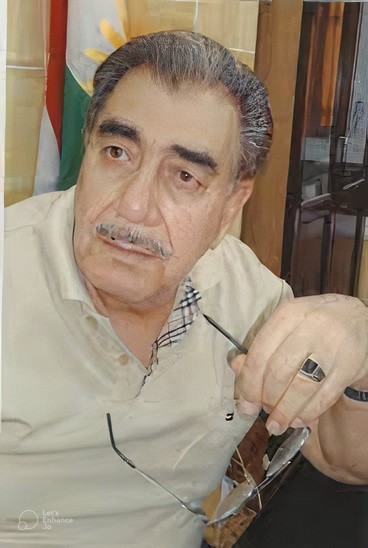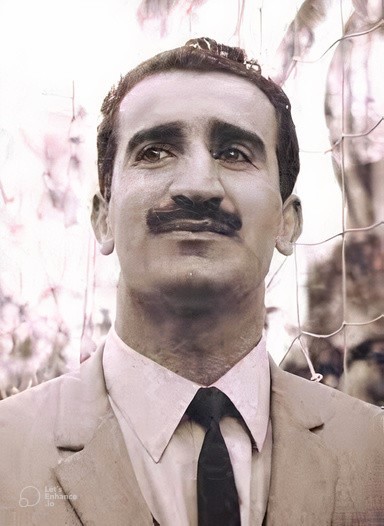Read part 3 of this article here
The South part of Kurdistan and Iraq (2)
In 1957, a group of theater advocates that included actors, painters, and musicians established the first Kurdish Fine Arts center in the Southern part of Kurdistan (1957_1963). The music players of "The Mawlawi music group", painters such as Anwar Touwi (1925_1994), Azad Shawqi (1930_2002), and Khalid Saeed (1927_1996), and actors such as Rafiq Chalak (1923_1973) and Taha Khalil (1940_2010) participated in this center's activities as members of it (Ahmadmirza, 2011:22). In 1958, the story of Mam and Zin was performed successfully by this center. For the first time in the Southern part of Kurdistan, a woman played the first role in a play.

Mawlawi Music Group

Azad Shawqi

Rafiq Chalak

Taha Khalil
The collapse of Hashemi's reign and the establishment of the Iraqi Republic in 1958 turned into a starting point for positive developments in Kurdish theater. "Gal Hall" was established in Hawler as the first suitable place for Kurdish theater performances. In Kirkuk, several play groups such as "Khabat Art Group" and "Kirkuk's Youth Group" were established. The "Kirkuk's youth group" held a ceremony for the collapse of the monarchy's reign in a play called "The Last Night" on January 14th, the anniversary of the revolution. Unfortunately, the optimism after the revolution did not last long since they were not totally fitting. The war between the Kurds and the Iraqis began and the Iraqi government banned the cultural and intellectual activities of Kurds in December 1961. During the war between Kurds and the Iraqis (1961_1979), the theatrical plays in Kurdistan had been generally stopped.

Gal Hall in the 1970 decade

Farhad Sharif
The establishment of autonomy in Kurdistan in 1970 was at the same time as the graduation of the first group of students who had studied theater at Baghdad University among whom were Sabah Abdul Rahman, Qazi Bamrni, Farhad Sharif, Tal'at Saman, Ahmad Salar, Badi' Dartash, etc. The return of this new generation at the end of 1969 and the beginning of 1970 revived the theater in the region and became the reason and the building block of the establishment of several special groups like "the Kurdish art and literature community", "Hawler art group", "Suleimani performance group" and "Gazizza Friends". These groups developed within a field in which they could use the national folklore myths, stories, and narrations, they could also challenge the political issues or even criticize them. "Kawa, the Smith" directed by Ahmad Salar, and "The End of a Tyranny" directed by Qazi Bamrni were examples of those plays that were produced after the autonomy.

Tal'at Saman

Ahmad Salar
The autonomy only lasted for five years. In April 1974, Baghdad attacked Kurdistan and after signing the Algerie treaty with Iran in March 1975, Baghdad got more powerful and succeeded. The Kurdish movement was suppressed and the freedom that had developed during the autonomy era ended. As the Baath regime enhanced its authority, the theater artists became a target of close observation by the regime. The plays were censored and since the plays potentially contained hidden messages were observed carefully by the regime. As a result of serious censorship, the Kurdish playwriters were forced not to write about their true goals and intentions and hide their political messages behind a bunch of symbols and signs. They had to write about topics that were the Arabs' favorites such as the Palestine situation so that they could express their dissatisfaction and disagreement with the regime through their plays (Rostami, 2019: 123-5). The suppression of the Palestinians by Israel was a good topic to compare with the suppression of the Kurds by Baghdad; this form of comparison in plays such as "Uprise the Palestinian Nation" was very prominent (Rostami, 2019: 115).
Despite the suppression by the regime and the Iran-Iraq war the 1970s and 1980s are recognized as the "golden era" of Kurdish theater in the Southern part of Kurdistan and Iraq by many. Although Kurdish plays were banned in a city like Kirkuk, in other cities such as Hawler and Suleimani it became a popular media for everyone. Opening the "Fine Arts Center" in 1980 was a significant step that became a building block for future artistic activities in Kurdish theater. Another more important event was the establishment of several theater groups during the 1980s such as "The head group of Kurdish Theater", "Salar Theater", "The Community of Kurds' Fine Arts", and "The Experiencing Theater".

Peshraw Kurdish Theater Group
Several attempts were made to organize the Kurdish theater at that time. While the Kurdish artists were playing several Arabic and western plays, they also were using their oral literature in order to perform plays such as "Mam and Zin" (1976) and "Dim Dim Castle" (1982)- written and directed by Tal'at Saman- and "Khaj and Siamand" (1976)- written by Foad Majid and directed by Ahmad Salar. At the end of 1980, Ahmad Salar whom we can say was the most active playwriter in Kurdistan, had a dream of a complete Kurdish theater by using the Kurdish culture and literature such as a play called "Nali and a Velvet Dream" (1987) and "When the eagle flies high" (1988).
Although the Southern part of Kurdistan and Iraq achieved autonomy in 1991 however, the economic pressures of Baghdad against the Kurds led to a disastrous civil war in Kurdistan (1994_1998) which resulted in a significant decline in theatrical activities in the 1990s. it was only after the war that the theater could revive once more and regain a part of its glorious history. Under the supervision of the Culture Ministry of the Kurdistan Region, theater offices were reopened in several cities. The establishment of "The Community of Fine Arts" in Hawler and later in Duhok was a big step in developing the theater. Special budgets were dedicated to theater and television programs.
However, the theater which was suppressed during the Baath regime and had many audiences remained alone after the autonomy even after the tickets were free. Theater in the Southern part of Kurdistan became weaker basically while the budgets were wasted and the training and use of the library sources declined. Despite all these, the Southern part of the Kurdistan Region as the only official Kurdish government has a significant role in preserving the Kurdish culture against the assimilation policies. Recording the anthology and special works of theater, especially the story of theater is very helpful in introducing the history of Kurdish theater.









